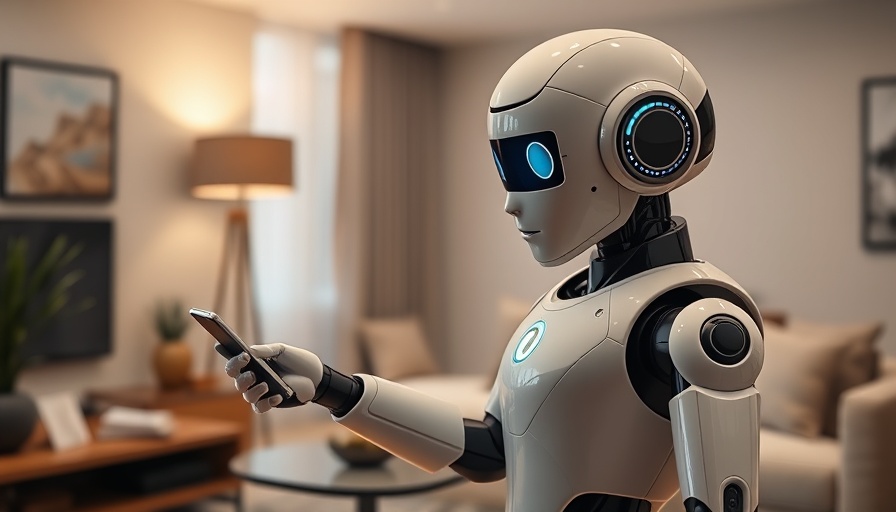
Humanoid Robotics: The Next Era of Home Automation
The discussion surrounding the role of humanoid robots in our daily lives has transitioned from speculative fiction to a tangible reality, as highlighted in the video "Robotics CEO: The Humanoid Robot Revolution Is Real & It Starts Now." CEO Bernt Bornich and David Blundin explore the innovations at 1X Technologies, showcasing their humanoid robot, Neo Gamma, which stands at the forefront of this technological evolution. The rapid advancements discussed during the video raise significant questions about how these innovations will reshape our homes, enhance personal convenience, and impact the workforce.
In "Robotics CEO: The Humanoid Robot Revolution Is Real & It Starts Now," the discussion dives into how humanoid robots like Neo Gamma are reshaping our daily lives, prompting deeper analysis of their implications for consumers and industries alike.
The Vision for the Next Decade
According to Bornich, the vision for humanoid robots involves creating machines that embody an abundance of labor and intelligence, directly influencing various aspects of everyday living. The shift towards using humanoid robots in homes emphasizes the need to provide greater efficiency and convenience in chores such as cleaning, food preparation, and even caregiving. The strategic decision to bring these robots into consumer spaces stems from the belief that they could replicate human interactions in functional roles that make life easier.
How Humanoid Robots Enhance Daily Life
Imagine coming home to find a humanoid robot ready to assist you with daily tasks—greeting you as you walk in, cleaning the living room, or even preparing a meal. The physical characteristics of Neo Gamma, described as light, safe, and capable of performing diverse functions, play a crucial role in this vision. The robot is being designed not just to execute tasks but also to learn and evolve, gathering rich data to enhance its operations. Bornich shared that by integrating AI with humanoid robotics, they aim to create interfaces that feel as natural as conversations with a human. As the robots gather more operational data in diverse environments, they will perform tasks with ease, adapting to the nuances of household dynamics.
Expectations vs. Reality: Embracing Imperfection
As exciting as the prospects of humanoid robots are, it's vital to maintain realistic expectations. The early adopter program seeks to involve consumers in the testing phase, where they will contribute to identifying improvements necessary for the robots to function optimally. Bornich emphasizes that while Neo Gamma will be functional and useful, it may not be perfect initially. However, involving real users in refining these robots builds a community around innovation and shared experience.
The Challenges of Integrating Robotics into Homes
The journey to integrate humanoid robots like Neo Gamma into commercial and residential settings is not without hurdles. Issues such as affordability, safety standards, and the ethical implications of having robots in personal spaces remain at the forefront of the conversation. As robots begin to step into caregiving roles, for instance, ensuring their reliability and performance in emotionally sensitive environments is paramount. Creating systems to prevent unintended consequences is crucial for both developers and society.
Market Growth and Economic Impact
The potential for humanoid robotics extends further, touching upon economic growth and labor markets. As Bornich predicted, addressing the future of labor alongside the emergence of robots brings about critical discussions about redefining work and comfort in our lives. The broader implementation of humanoids could lead to job displacement in some sectors while simultaneously creating new opportunities for innovation in technology and design.
Conclusion: A Future with Humanoid Robotics Awaits
The insights gained from the exploration of 1X Technologies and their humanoid robots serve as a lens to view the future of home automation and technology. As the CEO highlighted, we're embarking on the path toward a future filled with humanoid robots that not only serve functional purposes but also coexist seamlessly with our lifestyle. For businesses, especially in the franchise and service sectors, the rising trend of humanoid robotics presents not only challenges but also opportunities for growth and evolution.
As we reflect on the future challenges and possibilities that humanoid robots are set to bring, it's essential that franchisors and executives take an active role in shaping this integration. Understanding these dynamics will allow organizations to not only adapt but thrive in the ever-evolving technological landscape of business.
To explore how humanoid robotics can transform your operational strategy, it's worth considering engaging with industry discussions or following developments in the field. The time to start planning for the future is now.
 Add Row
Add Row  Add
Add 




Write A Comment